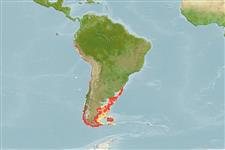Choromytilus chorus (Molina, 1782)
Choro mussel| Native range | All suitable habitat | Point map | Year 2050 |

|
| This map was computer-generated and has not yet been reviewed. |
| Choromytilus chorus AquaMaps Data sources: GBIF OBIS |
Google image | No image available for this species;
drawing shows typical species in Mytilidae.
Classification / Names आम नाम | उपशब्द | CoL | ITIS | WoRMS
Bivalvia | Mytilida | Mytilidae
Environment: milieu / climate zone / गहराई सीमा / distribution range पारिस्थितिकी
; खारा; गहराई सीमा 0 - 100 m (संदर्भ 356), usually 4 - 20 m (संदर्भ 89833). Temperate, preferred 12°C (संदर्भ 107945); 7°S - 56°S, 81°W - 52°W
Distribution देश | ऐफ ऐ ओ क्षेत्र | Ecosystems | संयोग | भूमिका
Southeast Pacific and Atlantic Ocean: From Pacasmayo, Peru to the Strait of Magellan and Beagle Channel including Juan Fernández Islands and to southern Brazil in the Atlantic including Falkland Islands. Introduced in the UK. Subtropical to temperate.
Length at first maturity / आकार / Weight / Age
परिपक्व अवधि: Lm ?, range 4 - 4 cm Max length : 26.0 cm SHL पुल्लिंग / अलिंग; (संदर्भ 126826)
Life cycle and mating behavior परिपक्व अवधि | पुनरुत्पत्ति | मछलीऔ का अंडे देना | Eggs | Fecundity | Larvae
Main reference
संदर्भ | संयोजक | सहयोगीयो
SAUP Database 2006 SAUP Database. www.seaaroundus.org. (संदर्भ 356)
IUCN Red List Status
(संदर्भ 130435: Version 2025-1)
CITES status (संदर्भ 108899)
CMS (संदर्भ 116361)
Threat to humans
Human uses
मात्स्यिकी: व्यापारिक
FAO - जलीयकृषि: production; मात्स्यिकी: landings | FishSource | Sea Around Us
साधन
अधिक जानकारी
संघटक आहार
आहार खपत
परभक्षी
इंटरनेट स्रोत
BHL | BOLD Systems | CISTI | DiscoverLife | FAO(मात्स्यिकी: ; publication : search) | Fishipedia | GenBank (genome, nucleotide) | GloBI | Gomexsi | Google Books | Google Scholar | Google | PubMed | Tree of Life | Wikipedia (Go, खोज) | Zoological Record



